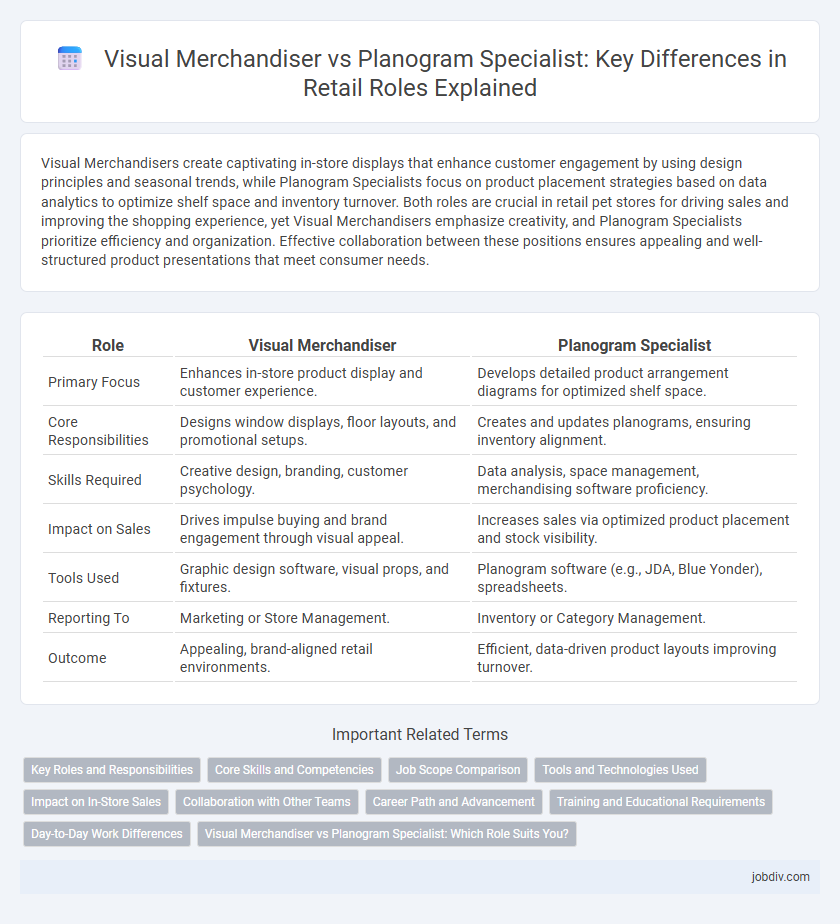Visual Merchandisers create captivating in-store displays that enhance customer engagement by using design principles and seasonal trends, while Planogram Specialists focus on product placement strategies based on data analytics to optimize shelf space and inventory turnover. Both roles are crucial in retail pet stores for driving sales and improving the shopping experience, yet Visual Merchandisers emphasize creativity, and Planogram Specialists prioritize efficiency and organization. Effective collaboration between these positions ensures appealing and well-structured product presentations that meet consumer needs.
Table of Comparison
| Role | Visual Merchandiser | Planogram Specialist |
|---|---|---|
| Primary Focus | Enhances in-store product display and customer experience. | Develops detailed product arrangement diagrams for optimized shelf space. |
| Core Responsibilities | Designs window displays, floor layouts, and promotional setups. | Creates and updates planograms, ensuring inventory alignment. |
| Skills Required | Creative design, branding, customer psychology. | Data analysis, space management, merchandising software proficiency. |
| Impact on Sales | Drives impulse buying and brand engagement through visual appeal. | Increases sales via optimized product placement and stock visibility. |
| Tools Used | Graphic design software, visual props, and fixtures. | Planogram software (e.g., JDA, Blue Yonder), spreadsheets. |
| Reporting To | Marketing or Store Management. | Inventory or Category Management. |
| Outcome | Appealing, brand-aligned retail environments. | Efficient, data-driven product layouts improving turnover. |
Key Roles and Responsibilities
A Visual Merchandiser is responsible for creating appealing product displays and store layouts that enhance customer experience and drive sales, focusing on aesthetics, brand consistency, and seasonal campaigns. A Planogram Specialist develops detailed schematics for product placement based on data analysis to optimize shelf space, inventory management, and shopper behavior. Both roles collaborate to boost retail performance through strategic presentation and precise execution of merchandising plans.
Core Skills and Competencies
Visual Merchandisers excel in creative design, spatial awareness, and customer psychology to craft engaging store displays that drive sales and enhance brand identity. Planogram Specialists possess strong analytical skills, proficiency in retail software, and attention to detail to develop product placement plans that optimize shelf space and inventory management. Both roles require collaboration with marketing and sales teams, but Visual Merchandisers prioritize aesthetics while Planogram Specialists focus on data-driven layout efficiency.
Job Scope Comparison
Visual Merchandisers focus on creating engaging store displays and layouts that enhance customer experience and drive sales through strategic product placement and aesthetic appeal. Planogram Specialists develop detailed visual schematics that standardize product positioning across retail locations, ensuring inventory compliance and maximizing shelf space efficiency. Both roles collaborate to optimize store presentation, but Visual Merchandisers emphasize creative design while Planogram Specialists prioritize data-driven shelf planning.
Tools and Technologies Used
Visual Merchandisers utilize design software such as Adobe Creative Suite and 3D modeling tools to create engaging store displays that enhance customer experience and promote brand identity. Planogram Specialists rely heavily on space planning software like JDA Space Planning and Blue Yonder, combined with data analytics platforms, to optimize product placement and maximize sales efficiency. Both roles integrate digital technology to align visual strategies with consumer behavior insights and inventory management systems.
Impact on In-Store Sales
Visual Merchandisers enhance in-store sales by creating engaging displays that attract customers and encourage impulse purchases, directly influencing shopper behavior. Planogram Specialists optimize product placement through data-driven layouts, improving inventory visibility and maximizing sales per square foot. Both roles significantly contribute to retail performance, but Visual Merchandisers focus on aesthetic appeal while Planogram Specialists emphasize strategic product arrangement.
Collaboration with Other Teams
Visual Merchandisers collaborate closely with marketing and sales teams to create engaging in-store displays that align with promotional campaigns and customer trends. Planogram Specialists work with inventory management and supply chain departments to design shelf layouts that optimize product placement and maximize space efficiency. Both roles coordinate frequently to ensure visual displays support stock availability and enhance the overall shopping experience.
Career Path and Advancement
Visual Merchandisers often start in entry-level retail roles and progress by developing strong design and customer experience skills, aiming for positions like Display Manager or Creative Director. Planogram Specialists typically advance through data analysis and spatial planning expertise, moving towards roles such as Retail Operations Manager or Category Manager. Both paths require understanding consumer behavior and retail strategy, but Visual Merchandisers focus on aesthetic presentation while Planogram Specialists emphasize product placement efficiency.
Training and Educational Requirements
Visual Merchandisers typically require training in design, marketing, or visual arts, often obtained through associate or bachelor's degrees, complemented by hands-on experience in retail environments to develop creative display skills. Planogram Specialists primarily need strong analytical skills and familiarity with retail software, often supported by backgrounds in business, supply chain management, or related fields, with certifications in planogram software or merchandising analytics enhancing their qualifications. Both roles benefit from continuous education in retail trends, software tools, and consumer behavior to optimize store layouts and product presentations.
Day-to-Day Work Differences
Visual Merchandisers design and implement eye-catching store displays to enhance customer experience and drive sales, focusing on aesthetics and brand storytelling. Planogram Specialists analyze product placement data and collaborate with supply chain teams to create detailed shelf layouts that optimize space and maximize inventory turnover. While Visual Merchandisers emphasize creative presentation, Planogram Specialists concentrate on strategic product arrangement based on sales metrics and shopper behavior.
Visual Merchandiser vs Planogram Specialist: Which Role Suits You?
Visual Merchandisers focus on creating engaging store displays that enhance customer experience and drive sales through aesthetic appeal and brand storytelling. Planogram Specialists analyze product placement data and design shelf layouts to optimize inventory visibility and maximize retail space efficiency. Choosing between these roles depends on whether you prefer creative, customer-facing work or data-driven spatial planning within the retail environment.
Visual Merchandiser vs Planogram Specialist Infographic

 jobdiv.com
jobdiv.com